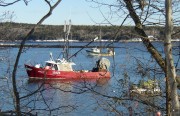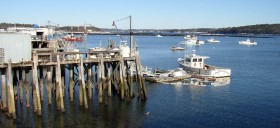In 1950, Maine had record seafood landings of 356,266,000 pounds without aquaculture. Maine ranked among the top seafood producing States. In 2009, the last year available for national seafood landings, Maine ranked 11th in pounds landed and 3rd in value.
The preliminary 2010 landings were 251,299,375 pounds including aquaculture valued ex-vessel at $450,664,717, an average of $1.79/lb. Seafood landings still contribute substantial economic activity even though landings are down by about a third since the record landings in 1950.
The comparison is complicated by the fact that aquaculture is included in the 2010 values and the mixture of species landed has changed significantly over the years. For example, Atlantic salmon produced in aquaculture accounted for 10% of the pounds and 18% of the value in 2010. American lobster accounted for 37% of the pounds and 70% of the value of all species.
Economic multipliers are not well understood, however, some industry sources believe that the total value of Maine’s commercial seafood exceeds 1.2 billion dollars. Recreational, party/charter boats and Maine fishing guides add additional benefits. As is the case with the commercial landings, the economic multipliers are not well understood.
In 2002, for the eighth year in a row, Maine’s fishermen landed more fish and shellfish than any other state fishery in the Northeast. Portland ranked second in the Northeast and fifteenth in the nation in the value of product landed. In summary, the harvesting profile looks like this:
- About 227 million pounds of fish and shellfish were harvested.
- 60 different species were harvested, see landing data on selected species.
- Lobster accounted for $207 million to the total landed value of $300 million.
- Atlantic Salmon landings were worth $17 million; clams, $15 million.
- 250 boats sold their products at the Portland Fish Exchange.
- Estimated full-time harvesters – 6000; estimated part-time harvesters – 4300.
- Total number of fishing harvesting licenses in 2000 was 18,000.
According to Coastal Enterprises, Inc., commercial fishing in Maine generates 26,000 jobs and is worth $740 million. It depends on just 25 miles of Maine’s coastal waterfront and on 53 fishing ports to get fish to market. Seventy-five percent of access to the waterfront is provided by private working residential and commercial wharfs; the balance is through public piers. See a chart, from Maine’s Department of Marine Resources, showing the number of active commercial harvesters in Maine by species.
Access to tidal flats, for the harvesting of clams and marine worms, is also critical and endangered as traditional access points are closed by coastal property owners.
Loss of commercial fishing takes many forms:
- Access to inter-tidal areas lost through no trespassing signs
- New coastal property owners closing off/contesting public access
- Commercial fishing access tenuous through lease arrangements
- Singular reliance on public facility—competition from other users
- Land-use access problem: limited parking
- Conversion of working wharves to residential/recreation private resident.
- Possibly most important, climate change affecting Casco Bay
Additional resources
Baron-Taltre, Benjamin. The Rise and Fall of the Maine Sea Urchin Industry: A Failure of Management and Institutions? 2005. (Thesis (M.S.) in Marine Policy–University of Maine, 2005) [University of Maine, Raymond H. Fogler Library, Special Collections]
Co-management [moving image recording]: The New England Town Meeting Goes to Sea. (presented by Mainewatch Institute and Island Institute. Camden, Me. Compass Light Productions. Rockland, Me. Island Institute (distributors). c1997.
Dow, Robert L. Effects of Climatic Cycles on the Relative Abundance and Availability of Commercial Marine and Estuarine Species. Augusta, Me. Maine Department of Marine Resources. 1977.
Hamlin, Cyrus and John R. Ordway. The Commercial Fisheries of Maine. Orono, Me. University of Maine. 1974?
Maine Department of Marine Resources. Program Review Committee. Program Review of The Maine Department of Marine Resources. Augusta, Maine. September 2, 2011. http://www.maine.gov/dmr/news/dmrreview9-2-11.pdf. (accessed November 28, 29011) Paragraphs 1-4 of this article, slightly reformatted, are from page 10 of the Review.
Maine. Department of Sea and Shore Fisheries. Commercial Fisheries of Maine. Augusta, Me. 1947. [University of Maine, Raymond H. Fogler Library, Special Collections]
Maine. Department of Sea and Shore Fisheries. Commercial Fisheries of Maine. Augusta, Me. 1957. [University of Maine, Raymond H. Fogler Library, Special Collections]
Maine. Department of Transportation. Evaluation of Maine’s Fish Pier Program. Augusta, Me. The Department. 1987.
Maine State Planning Office, Coastal Program, Augusta, Maine.
Sheehan, M. Elizabeth. Maine Fisheries: A Re-emerging Market. Augusta, Me. Coastal Enterprises, Inc., Maine Department of Marine Resources, 2000.
Sheehan, Elizabeth. Tracking Commercial Fishing Access: A Survey of Harbormasters in 25 Maine Coastal Communities. Portland, Me. Coastal Enterprises, Inc. Augusta, Me. Maine Coastal Program. 2004. [Maine State Law and Legislative Reference Library]







